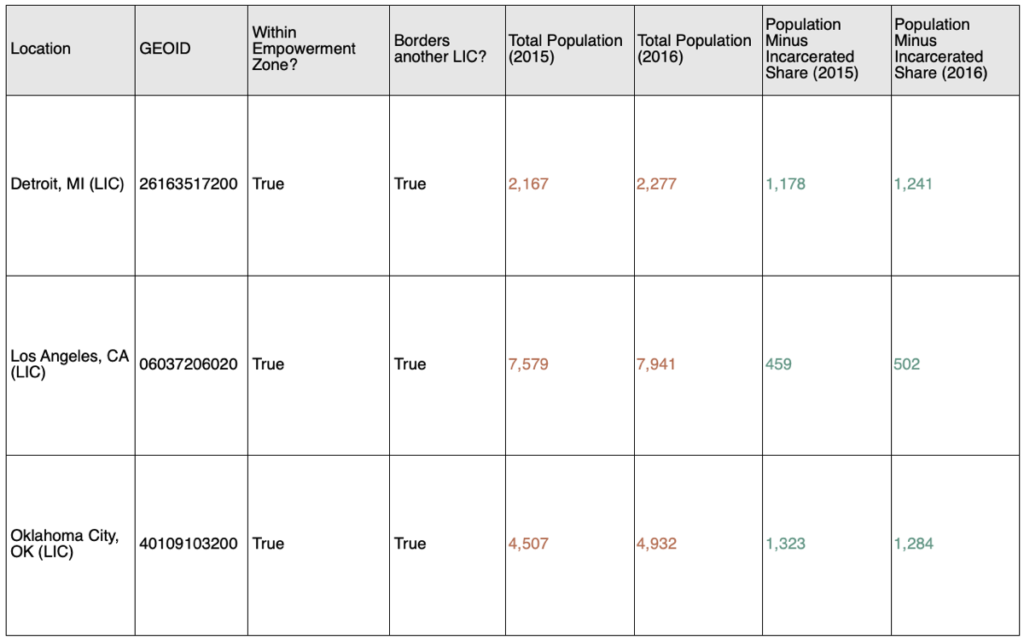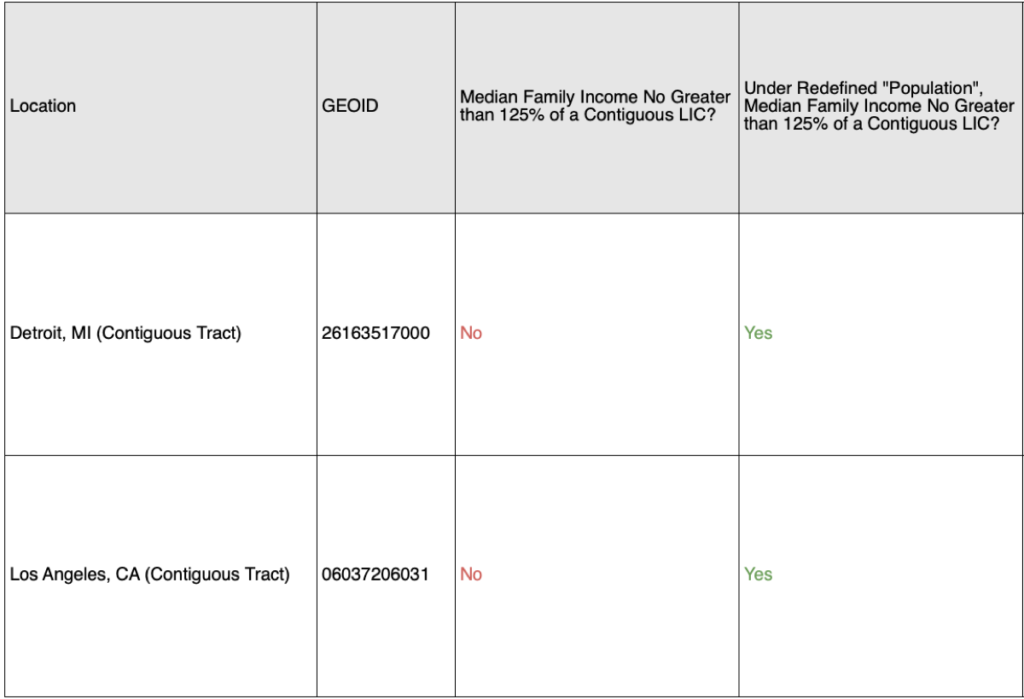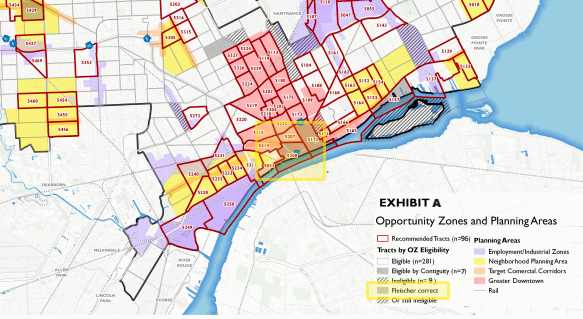A few of weeks ago, I identified three census tracts that were designated as Opportunity Zones through the Low-Income Community (LIC) criteria despite apparently not meeting the eligibility requirements. Two of these zones created their own branching, contiguous tracts, leading to a total of five dubious OZ classifications. While two of the LIC tracts could have achieved designation through an alternative method, the other three tracts would not have apparently qualified via any means. A detailed walk-through of my analysis is available here.
Further analysis has uncovered a likely explanation for what occurred regarding the three apparently miscategorized LIC tracts. Each tract should have been ineligible for having populations above 2,000. But if Treasury modified its definition of “population” to exclude prisoners, suddenly the very same tracts become eligible. My analysis suggests that this modification is the only avenue through which these, and only these, three census tracts could be designated LICs. That the revision occurred shortly after White House communication with lobbyists affiliated with Quicken Loans founder Dan Gilbert raises unique concerns. Yet independent of the motivation for the change, manipulating the definition of population directly undermines the intent of an OZ eligibility criterion aimed at regions experiencing population loss.
“Technical Corrections”
The three dubiously qualifying LIC tracts are located in Los Angeles and Detroit, and did not appear on the Treasury’s February 8, 2018, list of tracts eligible for designation as Opportunity Zones. One of these undesignated tracts, situated in Detroit, contains significant properties owned by Quicken Loans founder Dan Gilbert. As ProPublica’s investigative report uncovered, Gilbert donated $750,000 to Trump’s inauguration committee. At the time, tax reform was a far off election promise. But once the 2017 tax law passed, creating the Opportunity Zone program, his associates were heavily involved in Detroit’s OZ designation process.
In city planning maps uncovered by ProPublica, the vice president of government affairs for Dan Gilbert’s holding company, Jared Fleisher, can even be found “correcting” the eligibility of the dubiously qualifying LIC in Detroit. Indeed, the map’s legend indicates that that the recommended zone’s eligibility is “Fleisher Correct.”
Then on February 15, 2018, an email titled “Quicken”, was sent by Michigan economic development officials indicating that Quicken lobbyists had talked with the White House and to wanted to ensure they were “coordinated” on Opportunity Zones. Less than two weeks later, on February 27, 2018, the Treasury Department issued an updated list of eligible LIC tracts, describing the relevant changes as merely “technical corrections.”
Among the tracts added to this late update are the three dubiously qualifying LICs that I identified in my previous analysis, including the census tract “corrected” in Detroit planning maps by Gilbert’s lobbyist. As pointed out in my previous post, these three LIC OZs did not meet the statutory requirements under Section 45D(e) of the tax code based on admissible data during the relevant years. Family incomes were too high and poverty rates were too low to be designated OZs based on income. However, all three of these tracts fulfilled two out of three subcriteria for LIC eligibility as a “Tract with Low Population.” Tracts eligible via this avenue must 1) have a population of less than 2,000, and 2) be within an empowerment zone, and 3) be contiguous with one or more low-income communities. All three of the identified zones have populations that are too high to qualify, according to official data sources.
Yet all three of the dubiously qualifying LICs also contain substantial incarcerated populations. In the Detroit zone, this includes the Wayne County Jail, the Andrew C. Baird Detention Facility, and the Wayne County Juvenile Detention Facility. The Los Angeles tract contains the Men’s Central Jail and the Twin Towers Correctional Facility. Lastly, the Oklahoma County Jail is located in Oklahoma City’s questionably designated tract. When the substantial number of prisoners residing within these tracts are subtracted from these tracts’ total populations, the overall total drops below the threshold necessary for LIC designation. See table below for an illustration here:

Based on my analysis, modifying the definition of “population” to exclude prisoners is the only route by which these tracts, and only these tracts, could have achieved LIC status.
At first glance, subtracting prison populations may seem like a reasonable modification, particularly since the poverty rate does not include institutionalized populations. Nonetheless, this distorted definition of “population” substantially undermines the intent of the “Tract with Low Population” criteria that determined OZ eligibility. This criterion was primarily targeted at census tracts that experienced population declines over the previous decade. Following the decennial census, the Census Bureau requests that tract boundaries be drawn so that the average across all tracts within a county is roughly 4,000 persons per tract, with tracts typically ranging between 2,500 and 8,000 persons. The 2,000 person threshold for “Tract with Low Population” eligibility was chosen with the purpose of identifying tracts below the normal population bounds, and therefore most likely to be experiencing depopulation. The boundaries of tracts containing incarcerated populations would almost certainly be different if they were not included in the population total, meaning that their late omission by the Treasury constitutes a substantial manipulation of the law’s intent.
The ramifications of this manipulation are nontrivial. In both Detroit and Los Angeles, the contiguous tract criterion was employed in order to designate two affluent neighborhoods that happened to border the tract containing prisons as Opportunity Zones. The 2015 median family incomes (MFI) for these otherwise-ineligible contiguous tracts were $60,597 and $103,750 respectively, and both have a strong upward income trajectory, with MFIs of $82,115 and $112,109 in 2017. The tracts have no business being eligible for an incentive intended for struggling communities.

The unusually opaque description by the Treasury of their February 28 modification to the LIC criteria suggests that they were aware that modifying the definition of “population” in this way would be controversial. The investigative report by ProPublica suggests that lobbyists associated with Quicken Loans founder Dan Gilbert leveraged his access within the Trump administration to encourage the Treasury Department to manipulate the rules in order to personally benefit Gilbert. The knock-on effect of these dubious OZ classifications resulted in two additional zones being designated as contiguous tracts. Ultimately, without the Treasury Department’s unwarranted revision, the following census tracts would not have been designated as Opportunity Zones under current law:
- 06037206020
- 06037206031
- 26163517000
